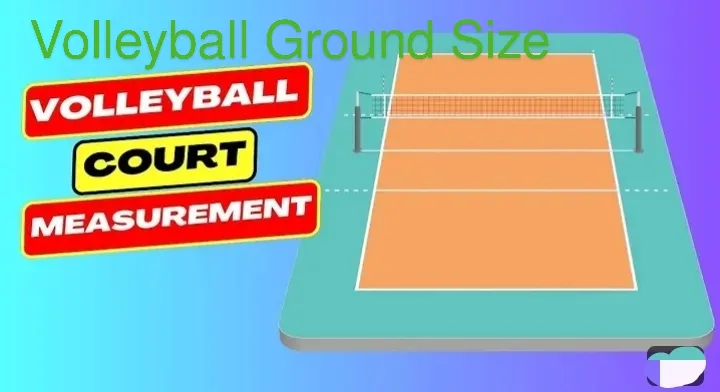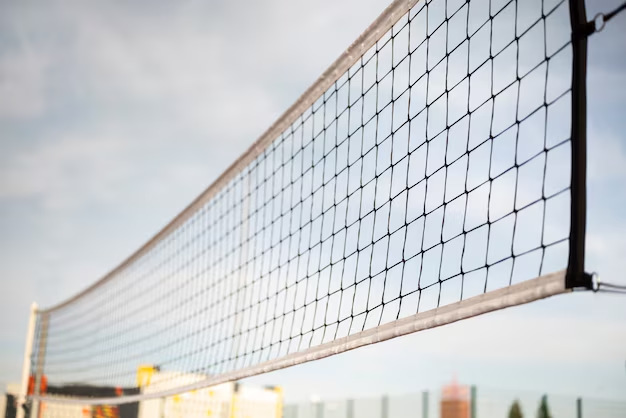When setting up a volleyball court, one of the most important things to consider is the volleyball ground size. Whether you’re playing indoor beach volleyball or simply enjoying a recreational game, getting the dimensions right ensures a fair and enjoyable match. In this article, we’ll cover everything from official court sizes to tips for measuring your own volleyball ground.
Volleyball Ground Size: The Basics
The official volleyball ground size depends on the type of volleyball being played. Indoor volleyball courts have different dimensions compared to beach volleyball courts. Indoor courts measure 9 meters wide and 18 meters long, while beach volleyball courts are slightly smaller at 8 meters wide and 16 meters long. These measurements are standard in all professional and competitive volleyball games, including international competitions like the Olympics.
Official volleyball ground size
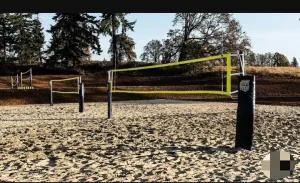
The volleyball ground size varies slightly between indoor and beach volleyball, though both have their own official dimensions.
Read More: Beach Volleyball vs Indoor Volleyball: Similarities and Differences
Indoor volleyball court
An indoor volleyball court measures 18 meters (59 feet) in length and 9 meters (29.5 feet) in width. The court is divided into two equal halves by a net. A key line on the court is the attack line, which is placed 3 meters (9.8 feet) from the net, creating a clear division for front-row and back-row players.
For example, when setting up a school volleyball match indoors, you would need a space that meets these precise measurements to ensure the game follows the rules.
Beach volleyball court
In comparison, the size of a beach volleyball field is slightly smaller, measuring 16 meters (52.5 feet) in length and 8 meters (26.2 feet) in width. There’s no attack line in beach volleyball, allowing more flexibility for players. The net height remains the same between indoor and beach, but the court’s sand surface requires additional consideration for boundaries and safety.
Why is the volleyball ground size important?
The volleyball ground size is vital because it impacts the way the game is played. A correctly sized court allows players to move strategically, anticipate plays, and ensures the match is fair for both teams. Too small a court would restrict player movement, while a court that’s too large can make it difficult for players to cover ground effectively.
For instance, in professional volleyball, court dimensions are strictly adhered to, and any deviation can lead to disqualification in international tournaments like the Olympics or FIVB championships.
How to Measure the Volleyball Ground Size
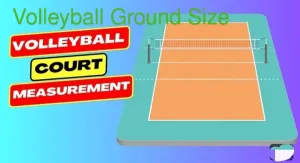
Setting up a volleyball court can be done with a few easy steps. Here’s how to accurately measure and mark your volleyball ground:
- Get the Right Tools: You will need a tape measure, stakes, and boundary lines (or chalk if indoors).
- Measure the Length: For an indoor court, measure 18 meters for the length, or 16 meters for a beach court.
- Measure the width: for indoor volleyball, measure 9 meters wide; for beach volleyball, 8 meters wide.
- Mark the Centerline and Net: Place the net in the middle of the court, dividing it into two equal halves.
- Draw Attack Lines (Indoor Only): Measure 3 meters from the net and mark the attack lines on both sides of the court.
Using these steps, you can ensure your volleyball court is correctly sized for both casual and professional play.
Volleyball Ground Size in International Competitions
For international competitions, like the FIVB World Championships or the Olympics, the volleyball ground size must meet strict guidelines. Courts must adhere to the 18m x 9m indoor or 16m x 8m beach dimensions, and the height of the net should be set at 2.43 meters (7 feet 11 5/8 inches) for men and 2.24 meters (7 feet 4 1/8 inches) for women.
Failure to comply with these dimensions could disqualify a team or venue from hosting official matches.
Common Mistakes When Setting Up a Volleyball Ground
There are some common errors when setting up a volleyball ground that can affect gameplay:
- Incorrect Court Size: Setting up a court that’s too small or too large can confuse players and disrupt the flow of the game.
- Misaligned Attack Lines: In indoor volleyball, attack lines should be exactly 3 meters from the net. Misplacing these lines can give one team an unfair advantage.
- Net Height Issues: An incorrectly set net height can make it harder for teams to score properly. Always double-check the net’s height based on the gender of the teams playing.
Adjustments for Recreational Volleyball
While professional volleyball has strict requirements for court size, recreational volleyball can be more flexible. If you’re setting up a game in your backyard or at a park, you might not have the exact space. In such cases, you can adjust the dimensions slightly to fit the available area. Just be sure the court remains proportional, with enough room for players to move around freely.
Volleyball Ground Size – Quick Facts
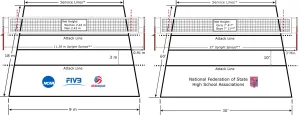
Volleyball Ground Size in Feet
For those who prefer measurements in feet, an indoor volleyball court measures 29.5 feet wide and 59 feet long. Beach volleyball courts, on the other hand, are 26.2 feet wide and 52.5 feet long. These conversions are helpful when marking out the court, especially in countries where feet are the standard unit of measurement.
Volleyball Ground Size in Meters
If you’re working in metric measurements, the volleyball ground size in meters is straightforward. As mentioned, the indoor court is 9 meters wide and 18 meters long, while a beach volleyball court is 8 meters wide and 16 meters long. These dimensions ensure consistent gameplay, whether it’s a local match or an international tournament.
Shooting volleyball ground size
When talking about shooting volleyball ground size, this refers to recreational or backyard volleyball, where the rules are slightly relaxed and the court size can vary based on space availability. For example, families setting up a volleyball game in the backyard may reduce the court size to fit their area. In this case, the size is typically smaller than the official court, but it still allows for enjoyable and competitive play.
Volleyball Shooting Ground Size in Feet
For informal games, such as backyard volleyball, a volleyball shooting ground size in feet could range from 20 to 25 feet wide and 40 to 50 feet long, depending on the space available. This provides enough room for players to move around but doesn’t require the full dimensions of an official court.
FAQs About Volleyball Ground Size
1. What is the standard volleyball court size?
The standard volleyball court size for indoor volleyball is 18 meters (59 feet) long and 9 meters (29.5 feet) wide. For beach volleyball, the court measures 16 meters (52.5 feet) long and 8 meters (26.2 feet) wide.
2. Is there a difference between indoor and beach volleyball ground sizes?
Yes, there is a difference. An indoor volleyball court is 18m x 9m, while a beach volleyball court is smaller at 16m x 8m. Additionally, beach volleyball does not have an attack line, allowing more freedom for players to move and spike the ball from anywhere on the court.
3. How high should the net be on a volleyball court?
The height of the volleyball net varies based on gender. For men’s volleyball, the net should be set at 2.43 meters (7 feet 11 5/8 inches). For women’s volleyball, the net should be 2.24 meters (7 feet 4 1/8 inches).
4. Can I adjust the volleyball ground size for casual play?
Yes, for recreational or casual play, you can adjust the volleyball ground size to fit the space you have available. Just make sure the court remains proportional and both teams are aware of any changes to avoid confusion during the game.
5. What happens if the volleyball ground size is incorrect?
If the volleyball ground size is incorrect, it can affect gameplay by limiting player movement or giving one team an unfair advantage. In official matches, incorrect court size can lead to disqualification or the match being replayed.
Setting up a volleyball court with the correct dimensions is essential for an enjoyable and fair game. Whether you’re playing casually with friends or preparing for a professional tournament, knowing the exact volleyball ground size will ensure everyone has a great time.

